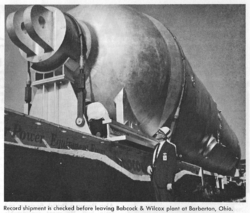Oconee Nuclear Station
| Oconee Nuclear Station | |
|---|---|
.jpg) Oconee Nuclear Station | |
| Country | United States |
| Location | Oconee County, near Seneca, South Carolina |
| Coordinates | 34°47′38″N 82°53′53″W / 34.79389°N 82.89806°WCoordinates: 34°47′38″N 82°53′53″W / 34.79389°N 82.89806°W |
| Status | Operational |
| Construction began | November 6, 1967 |
| Commission date |
Unit 1: July 15, 1973 Unit 2: September 9, 1974 Unit 3: December 16, 1974 |
| Construction cost | $1.961 billion (2007 USD)[1] |
| Owner(s) | Duke Energy |
| Operator(s) | Duke Energy |
| Nuclear power station | |
| Reactor type | PWR |
| Reactor supplier | Babcock & Wilcox |
| Cooling source | Lake Keowee |
| Power generation | |
| Units operational |
1 × 847 MW 1 × 848 MW 1 × 859 MW |
| Make and model | B&W LLP (DRYAMB) |
| Thermal capacity | 3 × 2568 MWth |
| Nameplate capacity | 2554 MW |
| Capacity factor |
97.43% (2017) 81.20% (lifetime) |
| Annual net output | 21,799 GWh (2017) |
The Oconee Nuclear Station is a nuclear power station located on Lake Keowee near Seneca, South Carolina, and has an energy output capacity of over 2,500 megawatts. It is the second nuclear power station in the United States to have its operating license extended for an additional twenty years by the Nuclear Regulatory Commission (NRC) (the application for the Calvert Cliffs Nuclear Power Plant in Maryland preceded it).
This plant has three Babcock & Wilcox pressurized water reactors, and is operated by Duke Energy.
Oconee was the first of three nuclear stations built by Duke Energy. According to Duke Energy's web site, the station has generated more than 500 million megawatt-hours of electricity, and is "the first nuclear station in the United States to achieve this milestone."[2]
In the summer of 2011 it became the first nuclear power station in the United States to have its sensors controlled digitally.[3]
Oconee is unique as it is the only nuclear power plant in the United States that does not rely on emergency diesel generator sets for emergency power. Instead it relies on two hydroelectric units at the nearby Keowee hydroelectric station. In the event the Keowee units are both out of service emergency power can alternatively be provided by combustion turbines at the nearby Lee fossil generating station. Both sources use alternative cables to supply Oconee's emergency systems that are independent of the Oconee switchyard and transmission lines which are the normal source of power.
Surrounding population

The NRC defines two emergency planning zones around nuclear power plants: a plume exposure pathway zone with a radius of 10 miles (16 km), concerned primarily with exposure to, and inhalation of, airborne radioactive contamination, and an ingestion pathway zone of about 50 miles (80 km), concerned primarily with ingestion of food and liquid contaminated by radioactivity.[4]
The 2010 U.S. population within 10 miles (16 km) of Oconee was 66,307, an increase of 11.5 percent in a decade, according to an analysis of U.S. Census data for msnbc.com. This includes the main campus of Clemson University. The 2010 U.S. population within 50 miles (80 km) was 1,404,690, an increase of 14.8 percent since 2000. Cities within 50 miles include Greenville (30 miles to city center).[5]
Seismic risk
The NRC's estimate of the risk each year of an earthquake intense enough to cause core damage to the reactor at Oconee was 1 in 23,256, according to an NRC study published in August 2010.[6][7]
Flood risk
Duke Energy has noted that a rapid failure of the Jocassee dam would flood the plant and cause the loss of power and safety equipment, potentially damaging its three reactor cores within 8 to 9 hours. It could further lead to reactor containment failure within 59 to 68 hours, triggering a significant release of radioactivity into the environment. Duke informed the NRC about this flooding hazard as early as January 1996.[8] Duke Energy estimated the probability of a random failure of Jocassee Dam is 1.3(10−5)/year, while the NRC puts the estimate at 2.8(10−4)/year.[9]
Subsequent to Fukushima, improvements were made to the Oconee site such that flooding from the failure of Jocassee Dam would not result in reactor core damage. The NRC has expressed satisfaction as of June 2016 with the flood protection modifications which included new or enhanced flood walls and moving some power lines and equipment to less flood-prone locations. [10]
See also
References
- ↑ "EIA - State Nuclear Profiles". www.eia.gov. Retrieved 3 October 2017.
- ↑ "Oconee Nuclear Station". Duke Energy. Retrieved 2008-11-17.
- ↑ http://www.kansascity.com/2011/05/29/2912054/sc-nuclear-plant-becoming-1st.html
- ↑ https://www.nrc.gov/reading-rm/doc-collections/fact-sheets/emerg-plan-prep-nuc-power-bg.html
- ↑ Bill Dedman, Nuclear neighbors: Population rises near US reactors, msnbc.com, April 14, 2011 http://www.msnbc.msn.com/id/42555888/ns/us_news-life/ Accessed May 1, 2011.
- ↑ Bill Dedman, "What are the odds? US nuke plants ranked by quake risk," msnbc.com, March 17, 2011 http://www.msnbc.msn.com/id/42103936/ Accessed April 19, 2011.
- ↑ http://msnbcmedia.msn.com/i/msnbc/Sections/NEWS/quake%20nrc%20risk%20estimates.pdf
- ↑ http://allthingsnuclear.org/dam-failures-and-flooding-at-us-nuclear-plants/
- ↑ Screening Analysis Report for the Proposed Generic Issue on Flooding of Nuclear Power Plant Sites Following Upstream Dam Failures page 9 http://big.assets.huffingtonpost.com/flooding.pdf
- ↑ http://scbiznews.com/news/energy/69800/
External links
- "Oconee Nuclear Power Plant, South Carolina". U.S. Department of Energy (DOE). October 3, 2008. Retrieved 2008-11-17.
- "Oconee 1 Pressurized Water Reactor". Operating Nuclear Power Reactors. U.S. Nuclear Regulatory Commission (NRC). February 14, 2008. Retrieved 2008-11-17.
- "Oconee 2 Pressurized Water Reactor". Operating Nuclear Power Reactors. NRC. February 14, 2008. Retrieved 2008-11-17.
- "Oconee 3 Pressurized Water Reactor". Operating Nuclear Power Reactors. NRC. February 14, 2008. Retrieved 2008-11-17.
- Williams, Buzz (Summer 1998). "Oconee Nuclear Station". The Chattooga Quarterly. Chattooga Conservancy. Retrieved 2008-11-17.